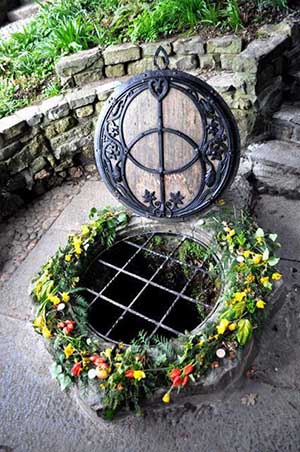The Well of Avalon
The Chalice Well is a famous and ancient well located in Glastonbury, Somerset, England. It holds historical, spiritual, and mythological significance and is considered a sacred site by various groups.
The Chalice Well is situated at the foot of Glastonbury Tor. Glastonbury is known for its rich spiritual and historical associations, often tied to Arthurian legends and mystical traditions.

The well has a history dating back to ancient times, and it is believed to be one of the oldest continuously flowing wells in Britain. It has been a source of natural spring water for centuries.
Over the actual wellhead is a protection cover known as the Chalice Well Cover. It is a small, domed well-house made of stone with a wrought ironwork grille. The design of the cover includes a Vesica Piscis, a Christian symbol representing the divine feminine and the sacred union of opposites.
Historical Roots and Christian Arthurian Perspective
The well itself is thought to have been built by those of the Old Religion, the Druids, and that the water the gushes from it, reddish in colour and tasting of iron, has been claimed to have magical powers.
According to legend the Chalice Well is believed to have sprung from the ground at the location where the Holy Chalice (the Grail), that Jesus drank from at the Last Supper and in which drops of His blood were caught during the Crucifixion, was placed here. The sacred vessel is believed to have been thrown into the well, or buried nearby by Joseph of Arimathea. The colour of the water and the taste according to legend is said to symbolize the iron nails that were used at the Crucifixion. Visitors can still drink the water which is today believed to possess healing properties. This belief can be traced back to the sixteenth-century. In recent years it has been found to be naturally radioactive.
Belief in the various healing properties of sacred springs, wells, and water itself are of ancient origin in the early Celtic Church, having a great significance also for the Old Pagan Religion. It is quite natural then that a sacred vessel should have given rise to a spring or to be contained within it. The significance of a well or spring depends on why it arose, and here there are central irrefutable points which should be considered, one being the belief that the water will possess the qualities of the person who gave rise to it or caused it to appear.
If we consider the Chalice Well, from a Christian Arthurian perspective the Holy Chalice is believed to have been the cause of its birth. If this is so, then the blood of Christ will have mixed with the waters, bringing enlightenment and possibly resurrection and life everlasting. These same gifts can be seen to be presented to Arthur in Taliesin’s (c. 534 – c. 599) poem The Spoils of Annwn.
And if we also consider the prospect of the Chalice Well being older, pre-Christian in origin, then the early writings of the Celtic Church and the knowledge of the arcane mysticism practised in Britain indicates the possibility that this was a well that was believed to provide a bridge to eternal life, perhaps the Underworld from Upper Earth. This may be associated with the knowledge of the magic cauldron from which waters were believed to provide the drinker with life after death. If the body of a dead person was immersed in the water from the cauldron, life was believed to be restored.
Whether you dispute any claims as merely fantasy or believe that such places do possess extraordinary powers, the Chalice Well like others is a place of pilgrimage. We cannot deny that water has appeared in most if not all Creation myths, and that its force, depth and beauty hold mystery for us yet to discover. Knowing that we are of water is perhaps what draws us to such places, perhaps because water is essential in our daily life for drinking and bathing, as something to obtain food from, to allow us to explore, or simply as a substance that encourages contemplation whether by a lake or the sea. Whether we come to be charged or to be cleansed by such places is immaterial to others, but why we are drawn to a particular place, perhaps at a particular time in our lives is of significance.
Archaeological evidence shows that the well has been in almost constant use for at least two thousand years! About 25.000 gallons of water runs there each day and even during drought it has never been dry.
Image credit
The Chalice Well, Glastonbury | Photo: Unknown
